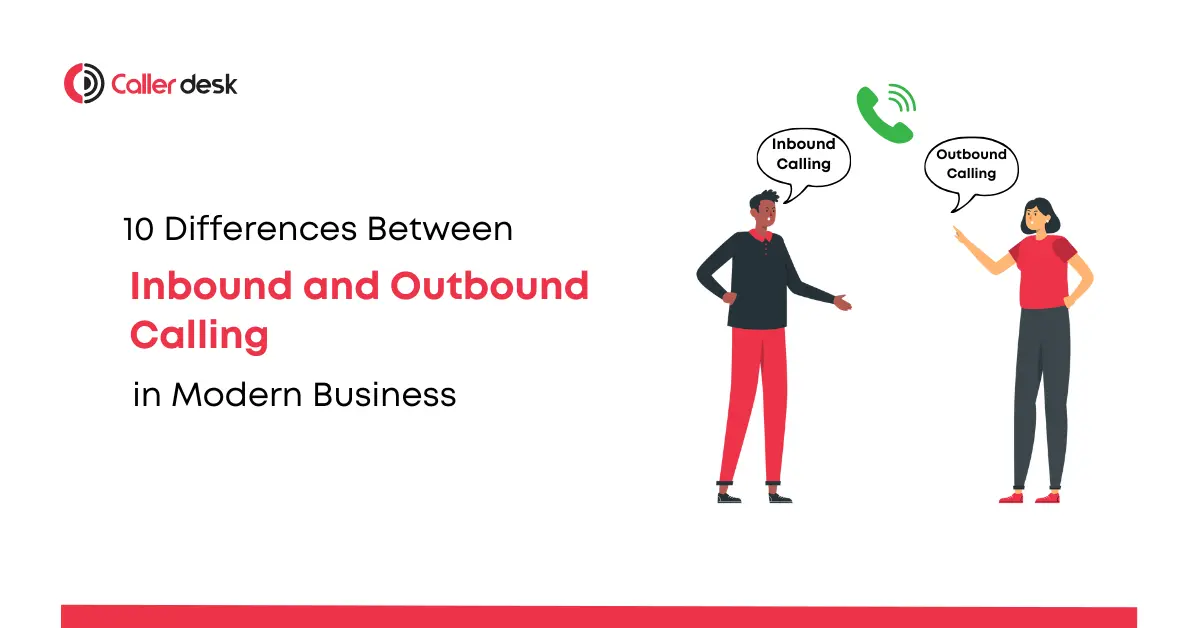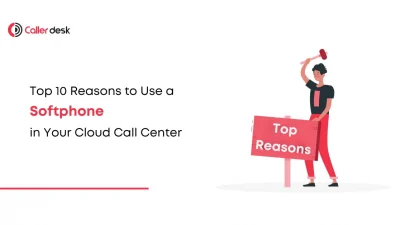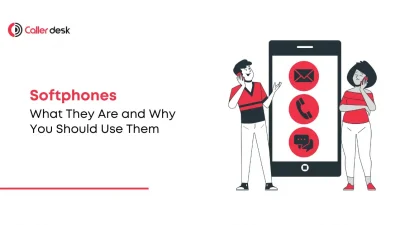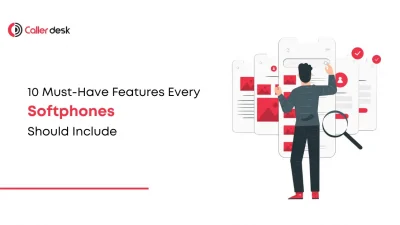Effective communication strategies are crucial for thriving in today’s competitive business landscape. Whether a company is striving to deliver excellent customer service or drive sales, understanding the distinctions between inbound and outbound calling is essential. Both approaches have unique roles in business operations, and leveraging the right tools can maximize their impact.
This guide explores the 10 key differences between inbound and outbound calling, providing actionable insights and highlighting how CallerDesk’s innovative solutions can help businesses excel in both areas.
1. Purpose of the Call
- Inbound Calls: These are customer-initiated interactions aimed at resolving issues, gathering information, or seeking support. For example, a customer might call to check their account balance or troubleshoot a product issue.
- Outbound Calls: Initiated by the business, these calls focus on sales, lead generation, or proactive customer engagement. A company might use outbound calls to pitch a new product or conduct a customer satisfaction survey.
CallerDesk Tip: CallerDesk’s predictive algorithms ensure that calls are routed efficiently, prioritizing urgent inquiries and connecting customers with the most qualified agents. This creates a seamless and satisfying experience for both parties.
2. Call Flow Initiation
- Inbound Calls: These are reactive processes, triggered by customer actions or needs. Businesses respond to inquiries in real time.
- Outbound Calls: These are proactive, initiated by the business to achieve specific goals like generating leads or collecting feedback.
3. Business Objectives
- Inbound Calls: Primarily focus on enhancing customer satisfaction and resolving issues promptly. Metrics like Customer Satisfaction (CSAT) and First Call Resolution (FCR) reflect the success of inbound strategies.
- Outbound Calls: Aim to drive business growth through sales, lead acquisition, and marketing campaigns. Key metrics include Conversion Rate and Revenue Per Call.
CallerDesk Advantage: Real-time dashboards from CallerDesk provide actionable insights into these metrics, allowing businesses to track trends, make data-driven adjustments, and proactively address performance gaps.
4. Required Agent Skillsets
- Inbound Call Agents: Must be empathetic, patient, and excellent problem solvers. Their role revolves around understanding customer needs and delivering timely solutions.
- Outbound Call Agents: Require strong persuasion, resilience, and negotiation skills. They must engage prospects, handle objections, and drive sales effectively.
Training Tip: Leverage CallerDesk’s call recording and monitoring tools to identify improvement areas and design tailored training modules. For example, agents can refine their approach by role-playing scenarios based on common objections identified through call recordings.
5. Technology and Tools
- Inbound Calls: Utilize tools like IVR (Interactive Voice Response) and Automatic Call Distribution (ACD) to efficiently route calls to the right agents.
- Outbound Calls: Depend on auto-dialers, predictive dialers, and campaign management systems to optimize outreach.
Why CallerDesk Stands Out: CallerDesk’s unified communication platform combines inbound and outbound tools, simplifying operations and enabling agents to handle calls seamlessly across both types.
6. Call Volume Management
- Inbound Calls: Volumes are influenced by external factors like product launches, marketing campaigns, or service outages.
- Outbound Calls: Call volumes are controlled internally, often based on targeted campaigns or sales initiatives.
Optimization Tip: Use CallerDesk’s intelligent scheduling features to predict call volumes and allocate resources efficiently during peak periods, ensuring no calls go unanswered.
7. Customer Interaction Dynamics
- Inbound Calls: Agents focus on solving specific problems or answering questions. Customers typically expect quick resolutions and empathetic responses.
- Outbound Calls: Agents must engage customers who may not anticipate the call. Their success relies on building rapport and demonstrating value quickly.
8. Performance Metrics
- Inbound Calls:
- First Call Resolution (FCR): Measures how often customer issues are resolved in the first interaction.
- Average Handle Time (AHT): Tracks the time spent on resolving each call.
- Customer Satisfaction (CSAT): Indicates how satisfied customers are with the service provided.
- Outbound Calls:
- Conversion Rate: Reflects the percentage of successful outcomes, like sales or appointments.
- Leads Generated: Tracks the number of prospects acquired.
- Revenue Per Call: Measures the financial return of outbound efforts.
CallerDesk Insights: CallerDesk’s real-time reporting tools empower businesses to optimize these metrics, refining scripts, training programs, and overall strategies to maximize outcomes.
9. Cost Implications
- Inbound Calls: Often viewed as a cost center, focusing on customer retention and support.
- Outbound Calls: Designed to be revenue-generating by targeting sales and marketing efforts.
Pro Tip: Minimize operational costs with CallerDesk’s cloud-based solutions, which eliminate the need for expensive infrastructure while offering scalable options for growing businesses.
10. Choosing the Right Strategy
The decision to prioritize inbound or outbound calling depends on your business objectives:
- Inbound Priority: Perfect for customer-centric businesses aiming to build loyalty and enhance satisfaction.
- Outbound Priority: Ideal for growth-focused businesses targeting lead generation, sales, or market research.
- Hybrid Approach: Combines the strengths of both, creating a balanced strategy tailored to business needs.
Framework for Decision-Making:
- Are you focusing on customer retention or acquisition?
- Do you want to resolve queries or drive proactive engagement?
- What is the current state of your sales pipeline?
Conclusion
Inbound and outbound calling are not competing approaches; they are complementary. By understanding their differences and leveraging advanced tools, businesses can achieve better customer engagement, operational efficiency, and growth.
CallerDesk’s all-in-one platform empowers businesses with the tools they need to manage both inbound and outbound calls effectively. From real-time analytics to AI-powered predictive dialing, CallerDesk ensures that every customer interaction adds value.
Ready to transform your call center? Contact CallerDesk today to schedule a free demo and explore how our solutions can revolutionize your business communication.
Frequently Asked Questions
1. What is the difference between inbound and outbound calling?
Inbound calling involves customers initiating contact with a business, typically for support, inquiries, or problem resolution. Outbound calling, on the other hand, is when businesses proactively reach out to customers for sales, lead generation, or surveys.
2. Why is it important to differentiate between inbound and outbound calls?
Understanding the differences helps businesses optimize their call strategies. Inbound calls are customer-driven and focus on retention, while outbound calls are business-driven and aim at growth. Tailoring strategies for each ensures better customer engagement and operational efficiency.
3. What metrics should I track for inbound and outbound call performance?
Inbound Calls: Key metrics include First Call Resolution (FCR), Average Handle Time (AHT), and Customer Satisfaction (CSAT).
Outbound Calls: Focus on Conversion Rate, Leads Generated, and Revenue Per Call.
4. How does CallerDesk help manage both inbound and outbound calls?
CallerDesk offers a unified communication platform that integrates tools like AI-powered predictive dialers for outbound calls and IVR systems for inbound calls. This ensures seamless call routing, improved agent productivity, and enhanced customer satisfaction.
5. What tools are commonly used in inbound and outbound call centers?
Inbound Call Centers: Tools like IVR, Automatic Call Distribution (ACD), and CRM systems help manage customer queries effectively.
Outbound Call Centers: Auto-dialers, predictive dialers, and campaign management tools streamline outreach efforts and enhance productivity.
6. How can businesses decide between focusing on inbound or outbound calling?
The choice depends on business objectives:
Inbound Focus: Ideal for customer retention and support-driven operations.
Outbound Focus: Best for growth-focused strategies like lead generation and sales.
Hybrid Approach: Combines both for a balanced customer engagement strategy.
7. What are the key skills required for inbound and outbound call agents?
Inbound Agents: Must excel in empathy, active listening, and problem-solving to resolve customer issues effectively.
Outbound Agents: Need strong persuasion, negotiation, and objection-handling skills to engage prospects and drive results.
8. How can CallerDesk improve my business’s inbound and outbound call strategies?
CallerDesk provides:
AI-Powered Predictive Dialers: For efficient outbound call management.
Real-Time Dashboards: To monitor performance metrics and adjust strategies.
CRM Integration: To provide agents with comprehensive customer data for personalized interactions.
Cloud-Based Solutions: That reduce infrastructure costs and enable scalability.
9. How can inbound calling improve customer satisfaction?
Inbound calls ensure customers receive timely and personalized assistance. Features like intelligent call routing and self-service IVR systems minimize wait times, resolve issues quickly, and improve overall satisfaction.
10. How does outbound calling help businesses grow?
Outbound calling drives sales, generates leads, and gathers valuable market insights. With tools like predictive dialers, businesses can reach more prospects in less time, enhancing efficiency and revenue generation.
11. Can CallerDesk support a hybrid call center strategy?
Yes, CallerDesk’s unified platform supports both inbound and outbound call management. This enables businesses to balance customer support and proactive outreach, optimizing overall communication strategies.
12. How can businesses reduce costs while managing high call volumes?
CallerDesk’s cloud-based solutions eliminate the need for expensive hardware, offer automated scheduling features, and optimize agent workloads, reducing operational costs while maintaining quality service.
13. What industries benefit the most from using inbound and outbound call centers?
Industries such as e-commerce, healthcare, financial services, telecommunications, and customer support-intensive businesses benefit significantly by effectively using inbound and outbound call strategies.





